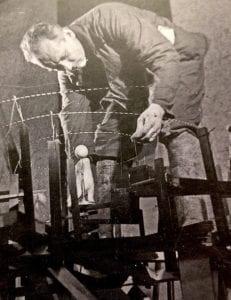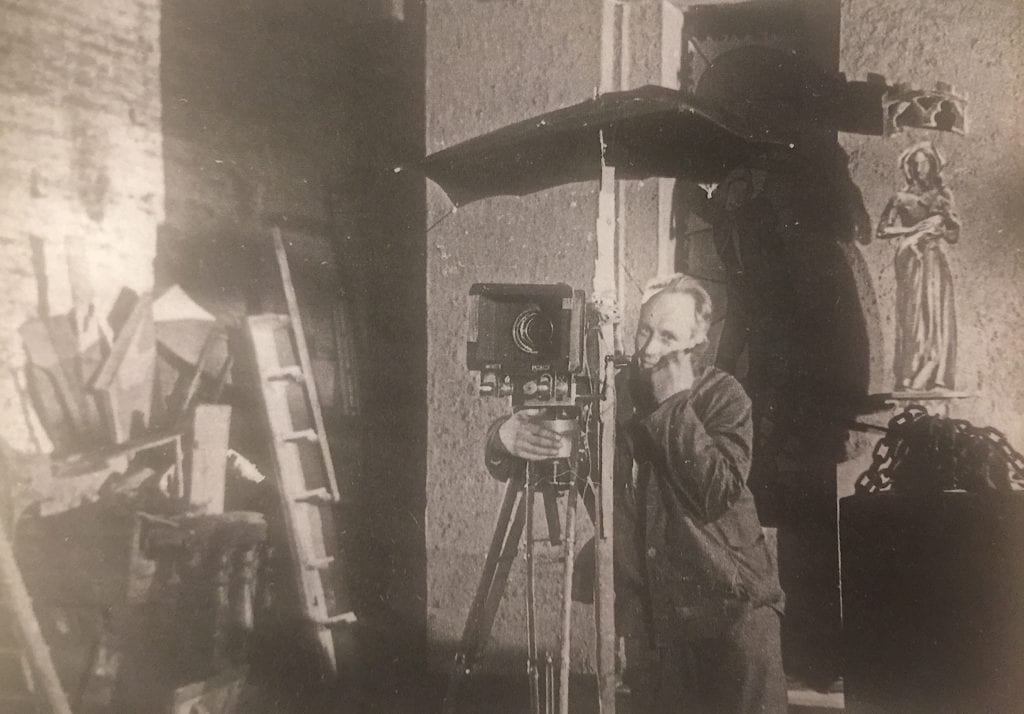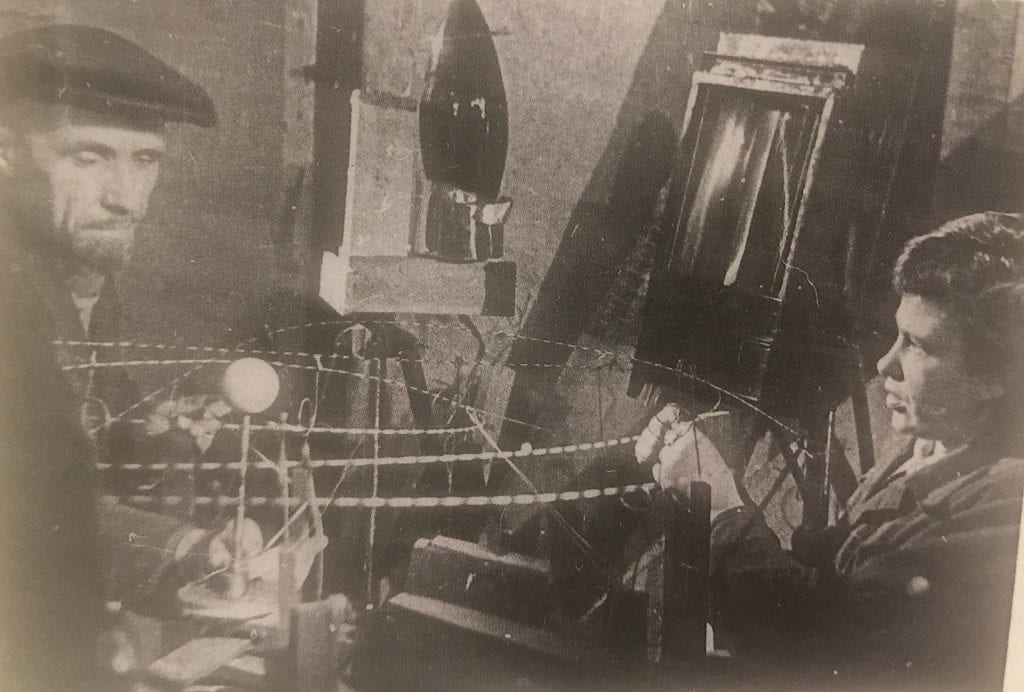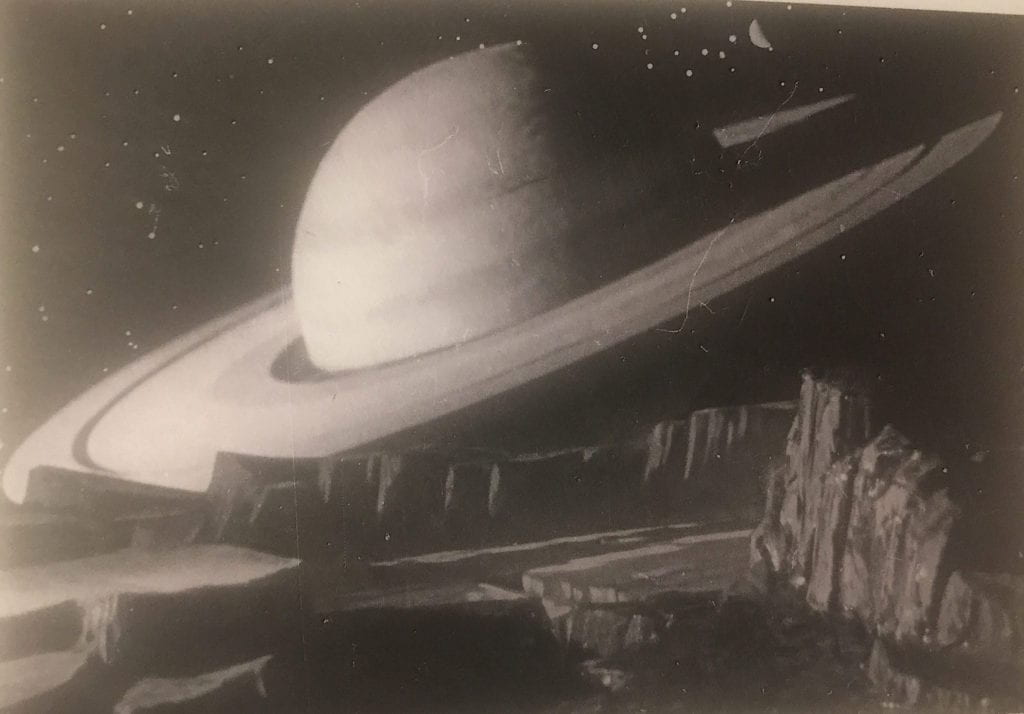Orphans in Space: Forgotten Films from the Final Frontier
special edition for Roger That! 2021
To say a filmmaker impacted astronomy itself might sound like an exaggeration. But there is a heavenly body, an astroid, officially called 321046 Klushantsev (2008 QL33).

The work of director, writer, cinematographer, and special effects maestro Pavel Vladimirovich Klushantsev (1910-1999) is on display here with the educational short Meteorites, made in 1947 at the Leningrad Popular Science Film Studio (aka Lennauchfilm). This is the first place to see this remarkable film on the web [save for a Russian-language torrent], but several of the director’s other films are unofficially on various web sites. He made films of various types from 1930 until his retirement in 1972. Most were not widely seen outside of the Soviet Union, although two of his feature films — Road to the Stars (1957) and Planet of the Storms / Planeta Bur (1962) — received some international distribution. Some filmmakers in North America and Europe saw these and marveled at the artistry and craft, particularly understanding the limited means he worked with. And how he navigated Soviet state-controlled production under Stalin, Khrushchev, and Brezhnev.
The 2002 Danish documentary The Star Dreamer, directed by Sonja Vesterholt and Mads Baastrup, is an excellent introduction to Klushantsev’s career. They located him shortly before his death, recording some interviews and obtaining footage from many of his films, including Meteorites. The documentary is available for subscribers to Alexander Street Press streaming service (and some free sites). And here’s To the Stars!, a short tribute from Lennauchfilm.
Another key English-language resource is “Klushantsev: Russia’s Wizard of Fantastika,” interviews by Lynn Barker and Oscar-winning visual effects artist Robert Skotak. These first appeared in American Cinematographer in 1994 and are in Russian Science Fiction Literature and Cinema : A Critical Reader, edited by Anindita Banerjee (Academic Studies Press, 2018).
More comprehensive is the website pavelklushantsev.ru, with biography, bibliography, images, books, and other resources.

Several of Klushantsev’s popular science films are currently viewable on YouTube, some with English subtitles. Looking at them, it becomes apparent that Stanley Kubrick in 2001: A Space Odyssey (1968) as well as George Lucas were influenced by Klushantsev’s visual design and fantastical vision that blended documentary and science fiction. Skotak says they influenced his work on Hollywood films (Aliens, The Abyss, Terminator 2). A more obvious way American cinema came to know the Soviet filmmaker: Roger Corman bought the rights to Planet of the Storms and had aspiring directors recut it for theatrical exploitation. Curtis Harrington released his cut as Voyage to the Prehistoric Planet (1965) and Voyage to the Planet of Prehistoric Women (1968) was the work of Peter Bogdanovich.
These are among the Klushantsev space films viewable online: The Universe (1951), Road to the Stars (1957), Planet of the Storms (1962), Luna (1965), I See the Earth! (1970), and, apropos this week’s widely seen video of NASA’s Mars Perseverance rover landing on the red plant, Mars (1968).
Photos from the set of Meteorites appear in the book В стороне от больших дорог / V storone ot bol’shikh dorog (Away from the Big Roads, 1994/2015), compiling several essays by Klushantsev about his film work.

Meteorites receives considerable attention, as he details the challenges in creating, lighting, and filming the mise-en-scene — models of the solar system, earth’s night sky, and meteors in space (before they fall to earth as meteorites).
The pavelklushantsev.ru site has a complete transcription of the book in Russian. Here is Klushantsev describing the production of Meteorites. (Caveat: English translation from Google.)
After Aurora Borealis [1946], my next picture was Meteorites. This time I wrote the script myself, taking into account the experience of the previous picture and new possibilities. The main thing in the technique of its shooting was the “luminescent method of shooting” developed by [A. V.] Lavrentyev and myself, without which the film simply cannot be made. Subsequently, the same method formed the basis for my other film The Universe.
In those years, at the studios of the country, in addition to the main work, research, so-called “R&D”s, were also carried out. It was necessary to send to Moscow. . . an application with a description of the problem and justification of the usefulness of the work, a brief description of the actions and an estimate for expenses, including salaries.
Lavrentyev and I carried out several such works, filling in the gaps between the pictures. But all of them were not associated with specific films, in contrast to the “luminescent method.” The idea came from Lavrentyev. He learned that in one of the Moscow clubs, tricks are shown on the stage using special colors that glow when a beam of ultraviolet light is directed at them. This light is invisible to our eyes. Some light sources, such as mercury lamps, emit ultraviolet in addition to visible light. There are special black glasses that transmit ultraviolet light, blocking visible light. If such glass is placed in front of a mercury lamp, then the room will be dark, and objects painted with luminous paints will be visible. This was the basis of the “miracles” that were shown in Moscow.
Lavrentyev talked with a Moscow “magician,” rummaged through the literature, went to the Institute of Optics, made connections with electricians and a mirror factory. A variety of glasses were brewed there. On our order, they then created black glass for us.
Lavrentiev was an inventive person in the sense of ideas, but completely helpless in terms of their implementation. Therefore, all organizational matters lay with me. And there were many problems. We had to get ourselves the chemicals needed to melt the black glass. It turned out to be very difficult to obtain glowing paints. The only place where we found them was the Moscow Institute of Non-Ferrous Metals. They were expensive and were not always in sufficient quantities. And yet we have gradually created a whole park of “black light” lighting devices (these are mercury lamps and special electrical appliances for them). This was done at the expense of pictures – Meteorites, and then Universe. And at the expense of two “research projects” on this topic – “Black-and-white shooting” and “Color shooting”.
There was one more difficulty. The fact is that black glass transmits a small amount of violet light. This does not interfere with the tricks on the stage. Filming is a completely different matter. The film takes it well. We found a way out. They began to put a weak yellow light filter in front of the lens. For black-and-white cinema, like Meteorites, this is not difficult. But when filming the color Universe, I had to tinker. The yellow filter could make the whole image yellow. Studied catalogs of colored glasses, their absorption curves, color sensitivity curves of colored films. It turned out that with a very strictly selected type of yellow filter when shooting, you can get a fairly good result when shooting color films.
All of this research work went hand in hand with the production of films in which luminescent photography was to be applied. But the problems were not limited to the creation of “black light” equipment. The fact is that the glow of objects painted with our paints was still not so bright as to shoot them at a normal speed of 24 frames per second. However, if you focus the light on a small area, normal speed is possible.
But we needed to shoot objects that occupy tens, and sometimes hundreds of cubic meters. Since it was not people who were to be filmed, but models, it was clear from the very beginning that we could only talk about time-lapse photography. But that’s not all. Objects are quite voluminous, so for a greater depth of field, you will have to set a large aperture. So it was necessary to shoot not only single-frame, but also with large exposures, and, therefore, very slow-moving. But that’s not all.
All shooting assumed the movement of models of celestial bodies. Motion in space, volumetric. The movement of the camera was also assumed, as if floating in space. All movements were supposed to be smooth, without any jolts or stops.
Considering all of the above, a system of mechanisms, methods and techniques was developed that would solve all problems.The filming camera always stood on a small camera crane, firmly fixed on wooden “sledges” that could move along wooden rails with sides. In time-lapse photography, the movement of the “sled” for each frame was measured in millimeters. To move this “block” with such precision and without jolts, cutouts were made along the sides of the rails, where the crossbar was laid. An automobile jack was laid horizontally between it and the “sled.” Rotating its knob for each frame by some pre-calculated fraction of a turn, we moved the “block” forward. When the jack rod was extended to its full length, the crossbar was rearranged into the next pair of notches, the jack rod rolled back to the beginning, and everything was repeated.

The movement of the subjects was of two kinds. Rotational (stars, planets) and rectilinear (nebula). All circular movements were achieved by mechanics – a carousel. Moreover, some of them were complex, individual objects in them rotated at different speeds. All straight lines were carried out by hanging the model on threads to the ceiling of the atelier and then pulling them to the side with a thread wound on a winch reel. The winch had a motor and two shafts rotating at different speeds. This allowed her to simultaneously pull several threads with different “step” sizes. The direction of the threads could be changed by means of suspended bars. As a result, we could move many objects in the frame with one motor, located in different places, moving in different directions and at different speeds. There was also an “exposure” motor in our system. It was turned on by the operator. After all, exposures for each frame vary from a few seconds to a minute, our “exposure” motor opened the shutter when the operator pressed the “shoot” button, and turned it off after as many seconds as we set on its contact drum. Thus, the same exposure was ensured throughout the shooting of the entire frame, and this time reached an hour or more. Such automation of filming sometimes allowed us, having previously adjusted everything, to leave the studio. The shot was filmed without us. But we rarely allowed ourselves to do this, usually someone stayed on duty. So all the filming of space frames of the film Universe was going on.
For this picture, one more machine was made – “Sun”. It was necessary to show a brightly luminous ball with a “boiling” surface. We made, according to my drawings, a system of concentric circles rotating from one drive, but at different speeds. At the Mirror Factory, we were blown several incomplete balls of different sizes from transparent glass, and the largest one from frosted glass. The balls were placed inside each other, each on its own disc. All transparent balls were covered with translucent spots. There was a bright lamp inside the stack of balls. The spots cast shadows on the outer matte ball. Due to the different speeds of rotation of the balls, the impression was created that the shadows were changing shape. On the surface of the “Sun” was “boiling”. With this machine, we also shot close-ups of stars and even planets like Jupiter….
After the success of my black-and-white one-reel piece Meteorites, which was not only well received in Moscow, but also received a diploma at the international festival in Venice (for the first time at our studio), Moscow realized that it was possible to include pictures on astronomical themes in the plan. . . .

Although I successfully made Meteorites, after the story with “Polar Lights” I went with the label “cosmopolitan”, which greatly hindered my nomination for staging one of the main films of the studio. In addition, many directors were against the idea that I, a good operator of combined filming, instead of making inserts for their pictures, suddenly got into directors, and even without a director’s education. The management was afraid, hesitated.
— from P. Klushantsev, Away from the Big Roads (1994/2015).
